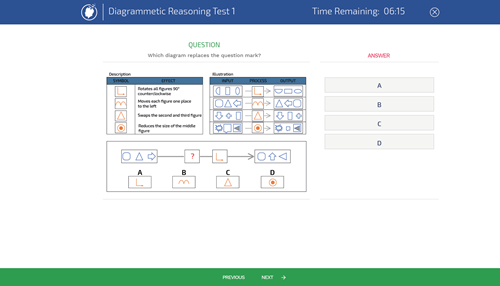- 206 Aptitude Tests
- 3281 Aptitude Test Questions
- One-off Payment
Tips to Pass a Diagrammatic Reasoning Test
What are Diagrammatic Reasoning Tests?
Diagrammatic reasoning tests are a medium for assessing an individual's abilities and determining whether they have the skills required for a specific job position. They may be part of an assessment center, especially the one conducted for management and engineering positions. These tests reflect the reasoning and logic-deducing capabilities of candidates for solving problems of convoluted nature.
The questions in the tests usually contain various sets of diagrams. All the diagrams in a particular set may be almost similar, with minor differences. The diagrams' differences are logically interrelated and follow a sequence.
Being a candidate, you must choose the correct diagram out of the given options that will immediately follow the last figure in the given set sequentially. To solve these tests, you must depend more on your analysis, reasoning, and decision-making skills than your acquired knowledge.
Example of what a syllogism test looks like:

Tips for Passing a Diagrammatic Reasoning Test
Though you cannot learn or acquire theoretical knowledge for diagrammatic reasoning tests, you can still master these exercises by following a few tips as given below:
- Observe the Sequence and Logical Flow Carefully
You should observe the given questions and diagrams carefully instead of hurrying and skimming through them. For solving the question easily, breaking the given sequence into parts and analyzing each of them separately is a good technique to employ.
Assigning labels to each of the operators may help you keep track of the changes induced by the operators and the resulting flow of the sequence. Using these techniques may be helpful in solving the questions appearing in the diagrammatic reasoning tests.
- Deduce the Next Logical Item before Considering the Answer Options
Instead of finding the correct answer from the given options, you should focus on the set of diagrams and figures that are in the question. You should try to determine the relationship between the given figures, find the variation, and infer the flow of change.
Deduction of the next figure that will fit in the sequence in question should be made without referring to the answer. Once you know what exactly you have been looking for, you can search for it among the given choices. Directly looking at the answers may be confusing. Moreover, the answer options will have multiple choices, and analyzing and comparing each one of them individually to the given pattern may take a lot of time and effort.
- Manage the Time and Pace of the Exam Well
Diagrammatic reasoning tests may be timed, requiring you to answer the given number of questions within the assigned duration. The time may either be assigned to the test as a whole, or it may be assigned per question. If time is assigned for the entire test, you will have the freedom to pace the test as per your wishes.
You may spend more time on sections that you find easier and less on sections that require considerable time and effort. However, if each question is individually timed, you must answer it within the designated time duration. In such a case, you should not rush through the questions and should focus on utilizing the time assigned to each question fully.
- Familiarize Yourself with the Test Format
The diagrammatic reasoning tests conducted by different companies may be different based on the area of expertise connected to a job role. While some companies may offer generic diagrammatic reasoning questions, others, like those related to science and technology and finances, may include complex sequential diagrams.
To solve these, the rules and their flows have to be determined and applied to a new situation. These are complex and intricate to solve and require a greater level of practice. You should ask the company about their inclusion in the test if possible, and you may even request samples to get to know the test format.
You should create a strategy beforehand on how you will go about the tests. Prior knowledge about the test structure may help you in this regard. Some of the diagrammatic reasoning tests may allow you to go back to the unanswered questions, while others may not give you the same provision. You should decide on a course of action based on the same.
If revisiting of unanswered questions is allowed, you may leave difficult and confusing questions for a later part of the test. But if the same provision is not available, which will be the case if each question of the test is timed separately, you should try to answer the question by utilizing the designated time for the question completely.
- Practice regularly
As diagrammatic reasoning tests are usually not based on knowledge but on your logical and reasoning abilities, the best way to master these tests is by practicing them a lot. Regular practicing will help you to be accustomed to the test and its pattern. It will also boost your analytical and logical skills over time, improving your performance on the test.
Different diagrammatic reasoning tests may have questions with varying levels of difficulty. If you have appeared in tests with only easy questions, practicing the hard questions will help you become more accustomed and proficient in answering these.
How can Assessment-Training.com help you ace your Diagrammatic Reasoning test?
Assessment-Training.com is your number 1 online practice aptitude test and assessment provider. Our aim is to help you ace your assessment by providing you with practice aptitude tests that mimic the tests used by employers and recruiters.
Our test developers have years of experience in the field of occupational psychology and have developed the most realistic and accurate practice tests available online. Our practice platform uses leading-edge technology and provides you feedback on your scores in the form of test history, progress, and performance in relation to your norm group.
Check out our tailor-made Diagrammatic Reasoning Test Pack to fully prepare you for your assessment.
The Assessment-Training.com data science team found that through practice, candidates increased their scoring accuracy and went into their assessments more confident. Remember, you need to practice to make sure you familiarize yourself with the test formats, work on your accuracy, and experience performing under time pressure.
Diagrammatic Reasoning
- 10 Tests
- 250 Questions
- One-off payment
- 206 Aptitude Tests
- 3281 Aptitude Test Questions
- One-off Payment
Diagrammatic Reasoning
- 10 Tests
- 250 Questions
- One-off payment
